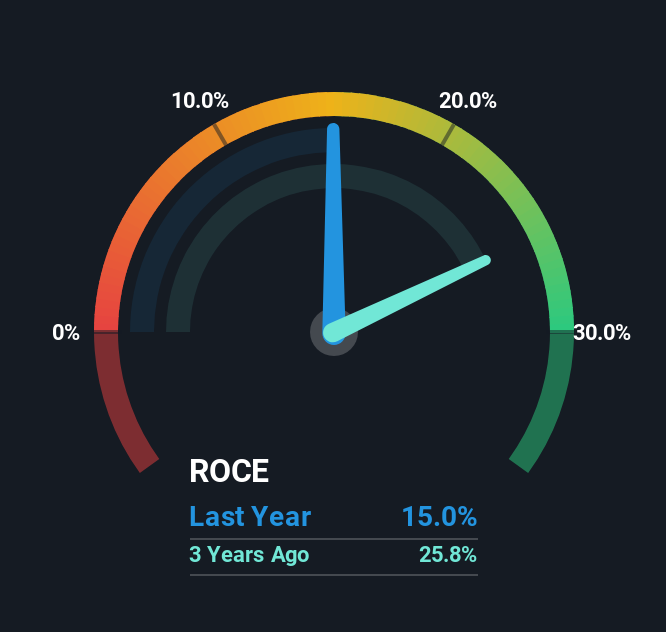Finding a business that has the potential to grow substantially is not easy, but it is possible if we look at a few key financial metrics. Amongst other things, we'll want to see two things; firstly, a growing return on capital employed (ROCE) and secondly, an expansion in the company's amount of capital employed. Ultimately, this demonstrates that it's a business that is reinvesting profits at increasing rates of return. Speaking of which, we noticed some great changes in Vista Energy. de's (BMV:VISTAA) returns on capital, so let's have a look.
Return On Capital Employed (ROCE): What Is It?
For those that aren't sure what ROCE is, it measures the amount of pre-tax profits a company can generate from the capital employed in its business. To calculate this metric for Vista Energy. de, this is the formula:
Return on Capital Employed = Earnings Before Interest and Tax (EBIT) ÷ (Total Assets - Current Liabilities)
0.15 = US$675m ÷ (US$6.1b - US$1.6b) (Based on the trailing twelve months to June 2025).
So, Vista Energy. de has an ROCE of 15%. In absolute terms, that's a pretty normal return, and it's somewhat close to the Oil and Gas industry average of 14%.
See our latest analysis for Vista Energy. de

In the above chart we have measured Vista Energy. de's prior ROCE against its prior performance, but the future is arguably more important. If you're interested, you can view the analysts predictions in our free analyst report for Vista Energy. de .
What Does the ROCE Trend For Vista Energy. de Tell Us?
The fact that Vista Energy. de is now generating some pre-tax profits from its prior investments is very encouraging. The company was generating losses five years ago, but now it's earning 15% which is a sight for sore eyes. Not only that, but the company is utilizing 302% more capital than before, but that's to be expected from a company trying to break into profitability. This can indicate that there's plenty of opportunities to invest capital internally and at ever higher rates, both common traits of a multi-bagger.
For the record though, there was a noticeable increase in the company's current liabilities over the period, so we would attribute some of the ROCE growth to that. The current liabilities has increased to 26% of total assets, so the business is now more funded by the likes of its suppliers or short-term creditors. It's worth keeping an eye on this because as the percentage of current liabilities to total assets increases, some aspects of risk also increase.
The Bottom Line On Vista Energy. de's ROCE
Long story short, we're delighted to see that Vista Energy. de's reinvestment activities have paid off and the company is now profitable. And with the stock having performed exceptionally well over the last five years, these patterns are being accounted for by investors. In light of that, we think it's worth looking further into this stock because if Vista Energy. de can keep these trends up, it could have a bright future ahead.
Vista Energy. de does have some risks, we noticed 3 warning signs (and 2 which are a bit unpleasant) we think you should know about.
If you want to search for solid companies with great earnings, check out this free list of companies with good balance sheets and impressive returns on equity.
New: Manage All Your Stock Portfolios in One Place
We've created the ultimate portfolio companion for stock investors, and it's free.
• Connect an unlimited number of Portfolios and see your total in one currency
• Be alerted to new Warning Signs or Risks via email or mobile
• Track the Fair Value of your stocks
Have feedback on this article? Concerned about the content? Get in touch with us directly. Alternatively, email editorial-team (at) simplywallst.com.
This article by Simply Wall St is general in nature. We provide commentary based on historical data and analyst forecasts only using an unbiased methodology and our articles are not intended to be financial advice. It does not constitute a recommendation to buy or sell any stock, and does not take account of your objectives, or your financial situation. We aim to bring you long-term focused analysis driven by fundamental data. Note that our analysis may not factor in the latest price-sensitive company announcements or qualitative material. Simply Wall St has no position in any stocks mentioned.
About BMV:VISTA A
Vista Energy. de
Through its subsidiaries, engages in the exploration and production of oil and gas in Latin America.
Good value with moderate growth potential.
Similar Companies
Market Insights
Community Narratives




